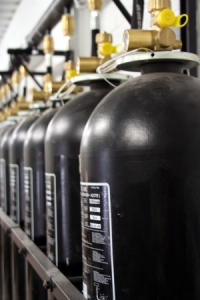 When planning an air conditioning system for their building, consultants, specifiers and building operators have to deal with regulations on fluorinated greenhouse gases, or F-gases. What are the implications of these regulations, since they are increasingly tighter than previous regulations and what can you do to mitigate the issues surrounding F-gas?
When planning an air conditioning system for their building, consultants, specifiers and building operators have to deal with regulations on fluorinated greenhouse gases, or F-gases. What are the implications of these regulations, since they are increasingly tighter than previous regulations and what can you do to mitigate the issues surrounding F-gas?
How effective have F-gas regulations been?
F-gas regulations were introduced by the EU in 2006 in order to meet the greenhouse emissions reduction targets set by the Kyoto Protocol, under which the EU has committed to taking them down to 8% below 1990 levels by 2012.
The main objective of F-gas regulations is to prevent leaks and defects, and ensure that once leaks are detected, they are repaired swiftly. This means that, when considering the use of air conditioning in a building, it is vital to plan for the containment of any gas used, to make sure that staff are qualified to respond to a leak, and to maintain traceability of the gas.
The regulations were tightened this year and as of 4th July 2011 companies involved in installing, maintaining or servicing stationary refrigeration, air conditioning or heat pump equipment must hold full certification under the UK REFCOM scheme. This latest update to the scheme requires much more rigorous levels of staff training and competence for those involved in refrigerant handling and leak testing.
Most recently, on 26th September 2011 the EU published a review of the F-gas impact and its progress against the original targets. (Download the EU report)
The review concludes that "the existing Regulation on F-gases is having a significant impact" but also that "without further measures, F-gas emissions are expected to remain at today's levels in the long term." F-gases today account for around 2% of EU greenhouse gas emissions.
If no further measures are taken and they stabilise at today’s levels, as predicted by the review, their share could grow substantially. This is because they are being used in a growing number of appliances, such as air conditioners. However the good news is that there are alternatives that do not rely on these refrigerants.
What can consultants, specifiers and building operators do?
-
Consider the use of units that individually contain less than 3kg of refrigerant, as they fall under the minimum level requiring compliance with F-gas regulations because of the small quantity of greenhouse gas they use.
-
Consider other types of systems, using other types of refrigerant. There are, for example, water-based systems. You can read more about this alternative in this article, published on H&V magazine: Sidestepping F-Gas.
-
Where larger units are necessary, consider external units for a complete system using renewable sources of energy, such as ground, water or air source heat pumps. You can read more about these systems in our blog post Look to the sky for energy, to the ground for storage.
Where does the responsibility for compliance lie?
It is important to keep in mind that the responsibility for complying with F-gas legislation lies with the end user, as is maintaining the details of the quantities of refrigerants and carrying out a mandatory annual inspection for systems using a refrigerant quantity exceeding 3 kg.
What’s next?
The EU has launched a public consultation, addressed to all interested stakeholders, in order to identify further cost-effective ways of reducing-gas emissions. The European Commissioner for Climate Action explained:
"The EU Regulation on fluorinated gases has successfully broken a growing trend in emissions and driven technological innovation. However, making the transition to a competitive low-carbon EU economy by 2050 requires ambitious action to cut emissions from all sectors. It is clear there is considerable scope for cost-effective reductions in F-gas emissions and following the public consultation I intend to propose new legislative measures next year."
If you want to have your say and take part in the consultation, you can find the link here: (http://bit.ly/o9DBEq).
Image: Tom Raftery
 Paul Langford is an Engineering Director with experience in product development, manufacturing and testing for HVAC, solar shading, louvre systems and smoke control applications.
Paul Langford is an Engineering Director with experience in product development, manufacturing and testing for HVAC, solar shading, louvre systems and smoke control applications.

